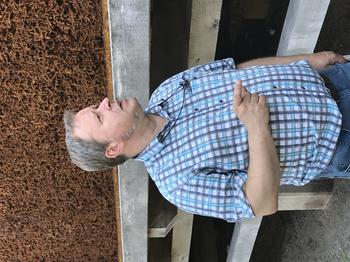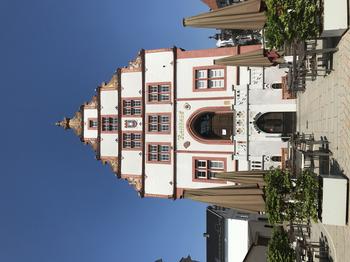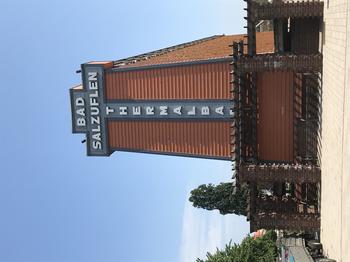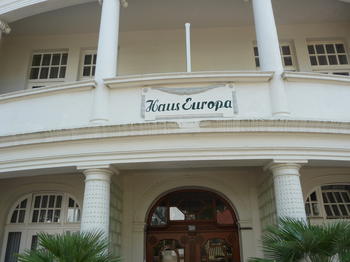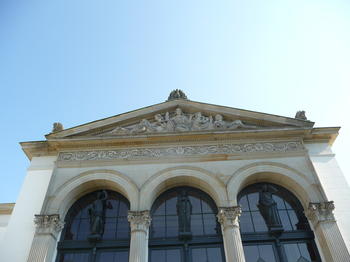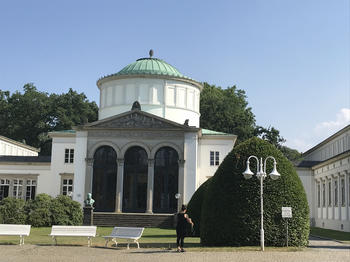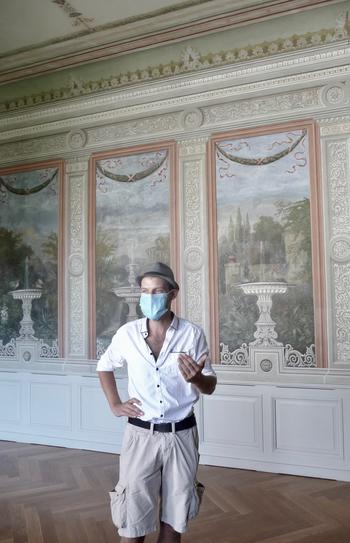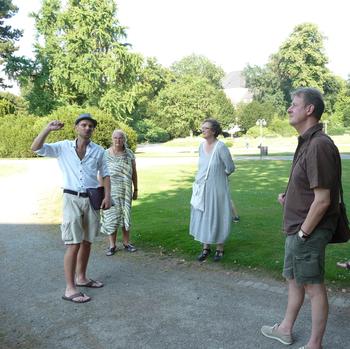Field Day at the Spas in Bad Salzuflen and Bad Oeynhausen
Bad Salzuflen Guided Tour with Arnold Beuke
Image Credit: The European Spa / Wiebke Kolbe
Bad Salzuflen Town Hall
Image Credit: The European Spa / Wiebke Kolbe
Bad Salzuflen Graduation Tower
Image Credit: The European Spa / Wiebke Kolbe
Bad Salzuflen Villa Haus Europa
Bad Oeynhausen Bathhouse 1
Image Credit: The European Spa / Henrike Schmidt
Bad Oeynhausen Bathhouse 1
Image Credit: The European Spa / Wiebke Kolbe
Bad Oeynhausen Guided Tour with Christian Barnbeck
Image Credit: The European Spa / Henrike Schmidt
Bad Oeynhausen City Tour with Christian Barnbeck and Michael Scholz
Image Credit: The European Spa / Henrike Schmidt
News from Sep 02, 2020
Making use of their summer boot camp at the Institute of Advanced Studies at the University of Bielefeld in Germany, the project’s four principal investigators undertook a field trip to the nearby spas of Bad Salzuflen and Bad Oeynhausen on 11 August 2020.
In Bad Salzuflen we met the town’s main archivist, Arnold Beuken, after having started the day with a plunge into recently built “Therme”. As a health resort, Arnold told us, Bad Salzuflen developed relatively late in its history, namely in the early 19th century. Before that, the town had thrived on the extraction of salt from various nearby sources, hence the name “Salz-uflen”. The half-timbered houses and bourgeois family houses in the old town bear witness to the wealth acquired through the salt trade, which entered into a period of crisis when elsewhere subterranean salt stock began to be exploited, allowing for a cheaper mass production. In Salzuflen’s case, the spa emerged as a by-product of the salt industry when people started to bath in or drink the brine in the mid nineteenth century. Shortly thereafter, the imposing thorn houses built for salt production were re-used as therapeutic facilities: the brine runs through a network of sturdy branches. The moist and salty air that is released is said to strengthen the lungs.
This pattern "from trade to promenade" is certainly not unique for Salzuflen, while the political circumstance that sparked of the building of the magnificent parks, drinking halls, hotels and villas are: the town was located in the small principality of Lippe, whose ruler prince Leopold decided to raise its profile by the second half of the 19th century, obviously inspired by other flourishing spas just beyond the limits of his territory, like Bad Pyrmont or Bad Oeynhausen. New splendid bathhouses, promenades and clinics were meant to raise the spa’s profile, yet the bulk of visitors, whose number skyrocketed around the turn of the century, came from the nearby industrial area of the Ruhrgebiet. In terms of numbers, Salzuflen rose to the ranks of the important spas in Germany, but its visitors recruited rather from the low middle and working classes. They came to enjoy the broad variety of Salzuflen’s natural spa resources and treatments: thermal and salt springs as well as Kneipp cures, and the associated bathing, drinking and inhalation treatments, with their cures largely paid by the emerging German social health insurance schemes.
Bad Salzuflen’s role as a major spa destination for Germans was briefly interrupted when after the Second World War British forces seized spa towns in the area and used its infrastructure as headquarters, a fate Salzuflen shared with Oeynhausen. After the British forces’ relocation to the Rhineland in the mid-1950, spa life resumed and turned Bad Salzuflen into one of the most frequented German health resorts, as the West German health insurance system paid for the bulk of vacationers until the 1970s. When it ceased to do so, the spa experienced a period of decay. Many of the splendid turn-of-the -century villas and baths had to be re-developed, and some of the massive post war clinics and hotel facilities that had replaced older structures during the boom years lost their purpose. Yet the town continues to exploit natural healing resources, built a new bath and preserved the thorn houses and the Kurpark area, for entering the latter visitors are charged a small fee. The former gallery (Wandelhalle) will house a small museum informing about Salzuflen’s history in the near future, on which Arnold and his colleagues are working at the moment. Salzuflen’s spa architecture is therefore not merely cultural heritage and urban decoration, but part of a still functioning Kurbad.
Our next destination was Bad Oeynhausen, located some 25 kilometers north of Salzuflen. We were attracted to this spa not least by the annual “poetic springs” (Poetische Quellen) festival, to which curator Michael Scholz invites an international crowd of writers, poets and translators to the parks of Oyenhausen for open-air public readings. The festival is decidedly promoting political themes, in 2020 the overall topic was "Resistance". And first of all, resistance was offered against the Covid-19 virus, not by ignoring it, but on the contrary by implementing all necessary restrictions, so that a successful realization of the events live was possible. The festival stands for the idea of bringing political debate into public places, in this case: to the spa. It is thus closely related to our understanding of the health resort as a public place.
Bad Oeynhausen’s history shares some features with Salzuflen’s, but differs from it in important ways. The spa emerged in the 1840s, also a by-product of the salt industry. In this case, the Prussian state, on whose territory the village of Rehmen was located, drilled for salt stocks aiming at an industrial exploitation. Although reaching a depth of 700m which was a fantastic achievement of the town, only a saline wells comparable to those of Salzuflen could be found, but with the support of Alexander von Humboldt it was decided to build a spa on the territory of the village, which received the name of the unsuccessful mining director, Karl von Oeynhausen. Royal patronage allowed for a lavish layout of the bathing facilities and their surroundings, in which we received a very instructive tour by Oeynhausen’s city guide, Christian Barnbeck. A trained archaeologist, Barnbeck willingly explained the architectural eclecticism that characterised the consecutive phases of the spa’s development. The founding days of 1840s reflected Schinkel’s influence on Prussian architecture and urbanism, with its unique blend of Greek and Roman antique elements, a statement challenging the French claim on classical heritage at the period. After the victory in the Prussian – French war of 1870-1, a newly erected bath by contrast cited French renaissance architecture and was followed by another bath erected in Nordic romantic style, mimicking the wooden church architecture of Norway. The huge Kursaal of the early 20th century, by contrast, reflected the international neo-baroque taste of the fin-de siècle and housed, among others, the casino.
In term of its generously planned layout and its lavish architectural décor, Bad Oeynhausen clearly stands out in comparison with modest Salzuflen and became a fashionable spa, easily reachable from the Prussian capital Berlin by direct rail connections. In terms of its international visibility, it did not quite reach a status comparable to other great German spas like Baden-Baden, Kissingen or Homburg, but it came reasonably close. After the First World War, a certain ‘democratization’ of the visitors occurred here as well. Like in the case of Salzuflen, the British requisition after the Second World War halted the development for another decade, during which, among others, the Norwegian style wooden bathhouse was lost to arson.
During the 1960s and 1970s, Oeynhausen attempted to serve a mass public, too, but it did so to a somewhat lesser degree than Salzuflen. Hence it preserved its ‘classic’ spa architecture to a larger degree than its neighbour and was perhaps less severely hit by the crises that followed from the cuts on recreational cures by the health insurance system in the 1970 and 1980s. Nonetheless, local politicians and spa administrators felt the need for a re-orientation, and they opted for attracting highly specialized clinics like a heart surgery centre, followed by a large number of other rehabilitation clinics. In so doing, Oeynhausen retained its image as a health centre, but ironically, since these clinics are largely self-contained unites, the old spa infrastructure, in particular the baths and the sources, fell into disuse or turned into a mere decorum, as in the case of the Kurpark and the Kursaal. The copious fountains, once fed by the sources, are nowadays operated with the waters of a nearby river.
Apart from being introduced to the histories of two spas in the region, which is always rewarding in itself, the field trip once more reminded us of the different development paths that existed within the European (and national) concepts of the spa town. Our visits and encounters with the local experts clearly illustrated the qualitative and quantitative changes that the twentieth century brought for spa towns, and the difficult choices they are confronted with at the beginning of the twenty-first. We are sincerely grateful to Arnold Beuken, Michael Scholz and Christian Barnbeck for providing us with so many helpful insights during out “field day”.

